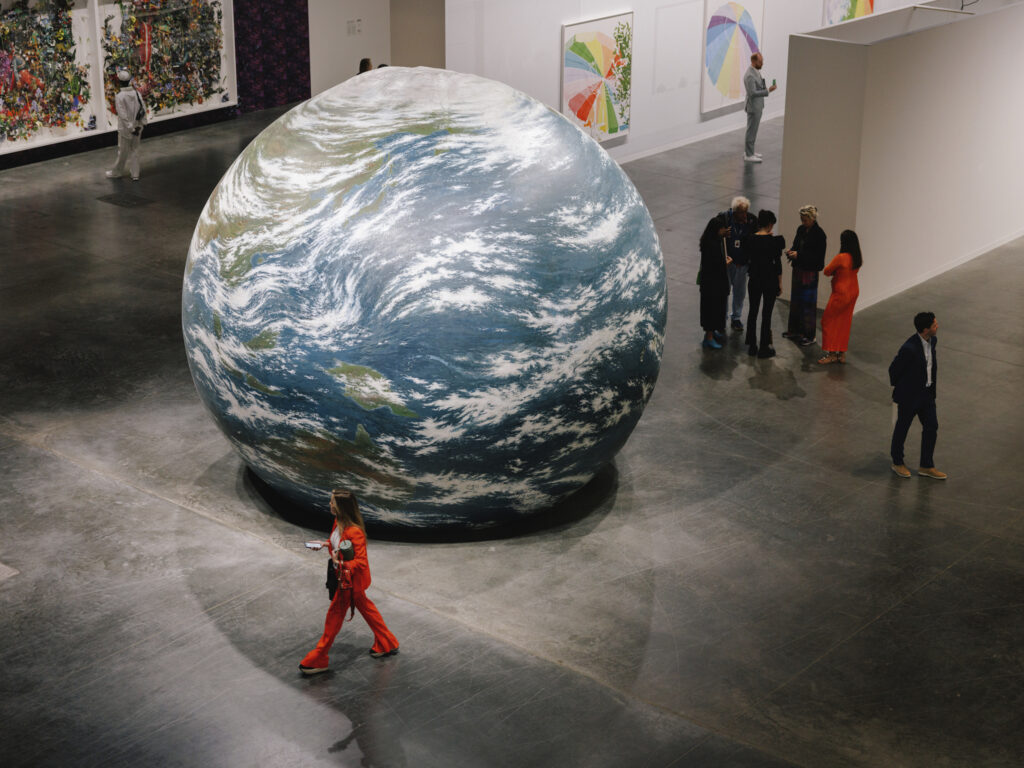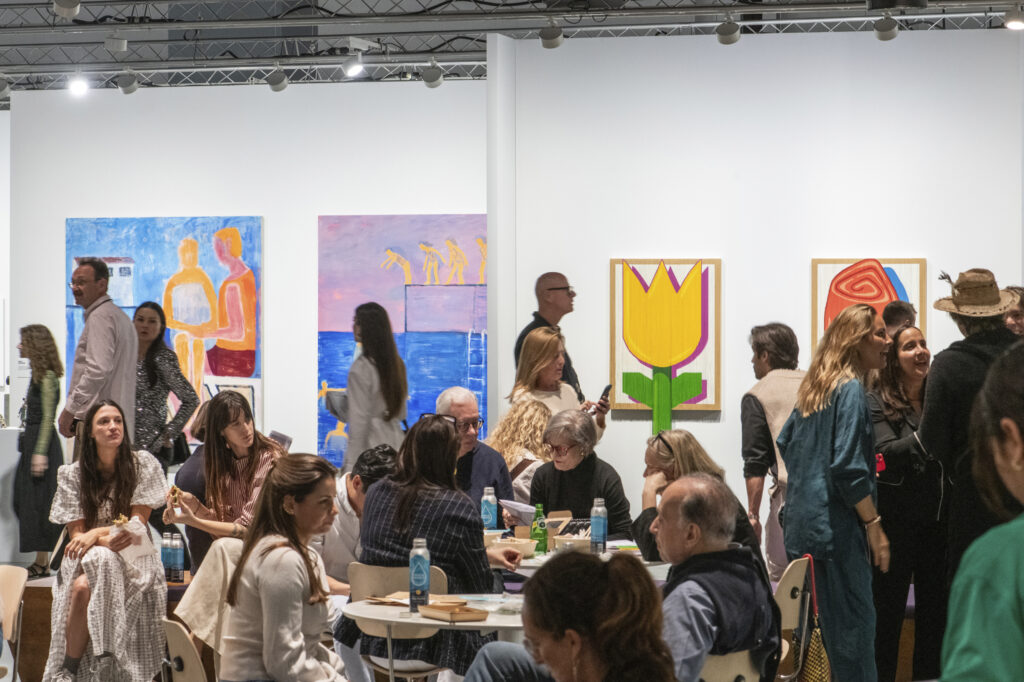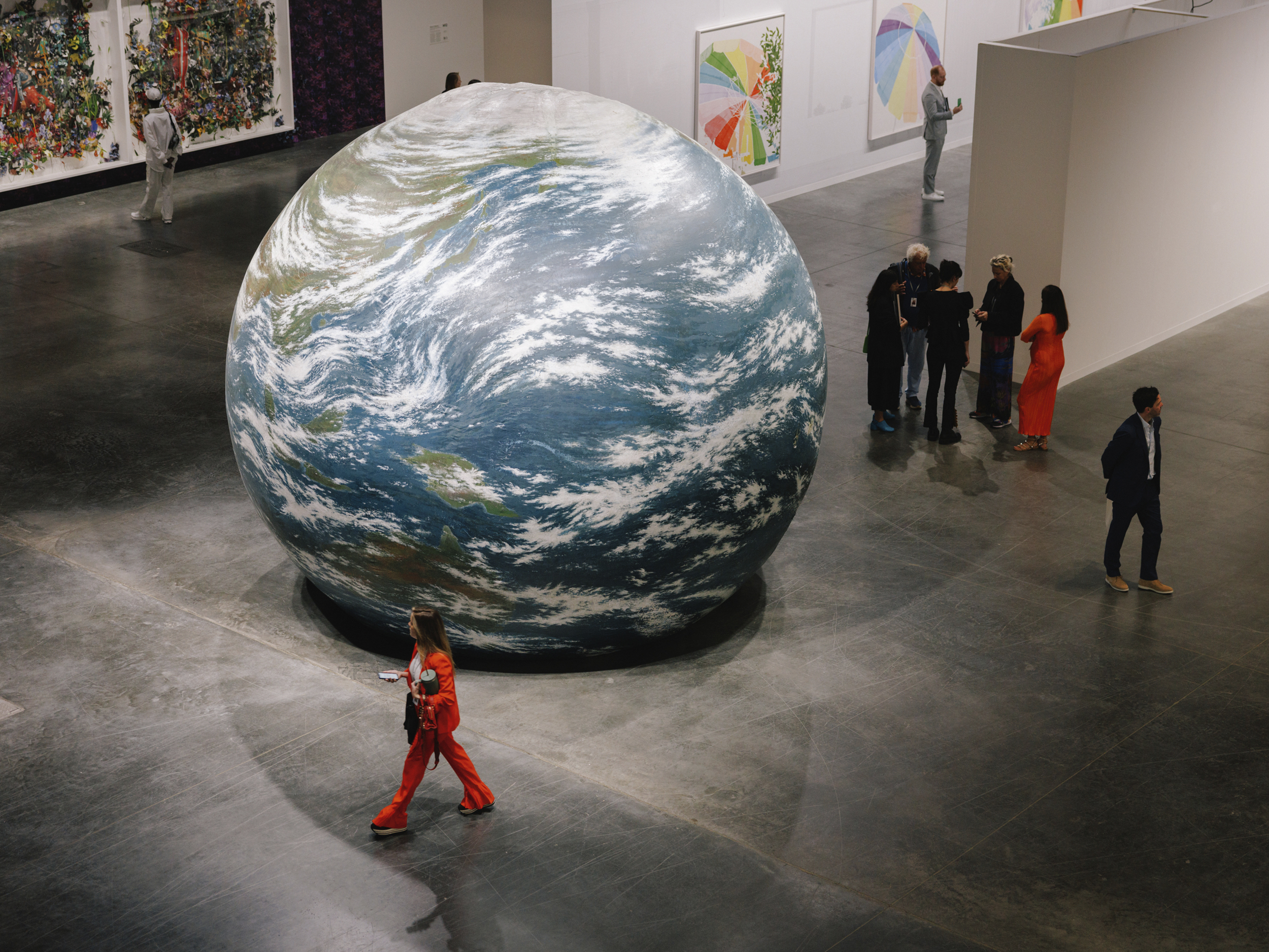Art Basel Miami Beach is synonymous with a city-wide extravaganza featuring raucous celebrity-studded parties, offsite brand activations, and viral artworks (remember the year a $120,000 banana-as-conceptual-artwork was eaten straight off a booth’s wall?) This year, while such events still occurred, their lights were slightly dimmed, with focus returning—for once—to the art itself.
In a reflection of this feeling, here is a selection of key artworks that underline themes found throughout the presentations at Art Basel Miami Beach 2024.

POWER TO THE FLOWERS— AND WOMEN
With the economy (and thus the art market) slower than usual this year, there was, as one art advisor told Artnet News, a lot of “living room art”—and who doesn’t love the look of a good bouquet on a coffee table?
At the Milan and New York-based gallery Kaufmann Repetto’s booth, flowers and trees took center stage in works by Andrea Bowers and Dianna Molzan. But as these artists show, natural lifeforms can speak to much more than providing a nice visual backdrop. For Bowers, who combines her artistic practice with activism and advocacy, natural motifs reflect her ongoing interests in eco-feminism, queer ecology, and magical fiction. In Miami, she presented Chandeliers of Interconnectedness (When Women Were Birds; quote used by permission of Terry Tempest Williams) (2022), a sculpture based on actual sycamore branches with budding leaves made of welded, recycled steel, non-toxic neon, and upcycled stained glass. On one branch is the titular quote by Tempest Williams, a renowned conservationist and author of environmental literature.
Molzan, meanwhile, often uses florals to upend expectations of what a painting can be. In Rose (2023), an almost cartoonish red rose is deconstructed. From afar, it appears to be a simple painting of the flower in the lineage of Pop Art; but up close, it becomes clear that the canvas has been unraveled, revealing the layer of poplar beneath and proposing sculptural qualities.
SEEING THE WORLD ANEW WITH TECHNOLOGICAL TOOLS
Los Angeles-based artist Emma Webster paints landscapes, yet she is not a landscape painter. Rather than painting landscapes we can see out a window, Webster conjures imaginative worlds with the help of VR. Beginning each work with a hand-drawn sketch, she then scans them into a virtual reality program, where she manipulates, exaggerates, and transforms the images, rendering them in 3D and developing what you could call digital landscape sculptures. These “sculptures” are then flattened and printed in 2D or referenced on an iPad she places next to a canvas, allowing the VR imaging to become guides for her large-scale, fantastical, and haunting oil paintings. “I’m not interested in VR as an end, but as a means of explorative sculpture,” Webster has said.
At Perrotin’s booth at the Miami Beach Convention Center, Webster debuted a new series of paintings inspired by rapturous phenomena. Her eerie yet naturalist vistas conflate terror and awe amidst unknown climates, prompting a reevaluation of our natural world. In Swallowed (2023), a giant green wavelike form swells from the bottom of the canvas to the top, breaking into white-and-turquoise foam. But the foam could also be icicles, and the uncanny height of the wave, examined up close, could be blades of grass. Or it could be a giant spew of vomit from an other-worldly, unseen creature. Such multiple readings are characteristic of Webster’s work and her use of VR to see the world anew while sublimely commenting on our environmental crisis. “We pigeonhole landscape painting as pleasant and boring, but there is nothing pleasant about a climate in crisis,” she has said.
HONORING QUEER HISTORIES
The theme of unearthing and honoring international queer histories resounded in many booths. One work that stood out was Untitled (SLUT- FORART) (2021), a painting by Korea-born, L.A.-based artist Kang Seung LeeLee, whose practice is rooted in honoring his queer ancestors, particularly those who were lost to AIDS. Shown by Commonwealth & Council, the work resembles a black t-shirt emblazoned with “SLUTFORART”— a motto of the late Chinese-American photographer Tseng Kwong Chi—in white text. Kwong Chi, who was an integral part of the East Village art scene in the 1980s, often wore badges with this motto until his death from AIDS-related illnesses in 1990.
Also at the Commonwealth & Council booth was a series of drawings by Seung Lee, who used graphite to recreate a number of Kwong Chi’s self-portraits. In the crystal-clear original images, Kwong Chi donned a Mao suit while posing in front of landmarks like the leaning Tower of Pisa, the Colosseum, and the Christ the Redeemer statue in Rio de Janeiro. In Seung Lee’s drawings, however, the artist’s figure is blurred—“a haunting reminder that Kwong Chi has slipped away from us, even if his works remain,” as critic Maximilian Durano wrote in ArtNews.
Miami-based artist Pepe Mar is also known for exploring queer histories, exemplified by his assemblage that was on view at David Castillo Gallery’s booth. To create the plexiglass-encased work, Mar sourced an array of objects from LGBTQ thrift stores that he visited multiple times a week for months on end. He repurposed fragments from things like buckets, vases, animal figurines, and clothing to create a fantastical creature meticulously crafted and imbued with the ghostly legacies of bird heads, beads, coiled wood, and the traces of fabric he glued to the background and then ripped off.
WHO SAYS SIZE DOESN’T MATTER
Some of the most standout artworks at this year’s fair were of massive scale. Specifically, crowds constantly surrounded and photographed two new works by renowned artist Ai Weiwei: Sleeping Venus (2022) at Galleria Con- tinua and Washington Crossing the Delaware (2023) at Neugerriemschneider. The works reference historical masterpieces in supersize; both of them exceed 16 feet in width and 10 feet in height and are made with hundreds of thousands of Legos. Ai has worked with Legos since 2014, using the medium to replicate Old Master works and, as a representative from Continua told the Art Newspaper, “tell a story between something very valuable [and] historical and something very capitalistic and contemporary.” Legos also disrupt the iconic-ness of images, the artist has explained: “I hate when something that you’re looking at is iconic so I want to destroy that with humor or something [like] Legos, a very casual material.”
Indeed, Ai is known for his ability to create works that are both visually stunning and socially resonant. For his version of Renaissance painter Giorgione’s 1510 Sleeping Venus (1510), which Ai made shortly after Roe v. Wade was overturned, the artist added a coat hanger in the bottom left corner, a nod to back-alley abortions. As the gallery representative continued, “It’s a commentary on the repression of rights, especially women’s rights.”

WHAT TO EXPECT IN 2024 AND BEYOND
Many galleries chose to present works by artists who are sure to make headlines in the years to come. New York’s Ryan Lee Gallery, for example, highlighted the late Vivian Browne, an under-recognized artist of historic significance. During her lifetime, she created African American protest paintings and developed novel ways of linking abstraction to nature. Browne painted the works shown in Miami after a career-altering trip to West African countries in 1971. There, the colors and patterns both astounded and overwhelmed her. When she returned to her studio in New York, she translated what she saw and felt into beautiful abstractions that continue to resonate and radiate five decades later. Come 2025, Browne will finally receive her due with the first-ever museum retrospective dedicated to her work, co-organized by the Phillips Collection in Washington D.C., and the Contemporary Arts Center in Cincinnati, OH.
Elsewhere, the David Kordansky Gallery inaugurated its representation of Sam McKinniss, an immensely talented painter of modern life, with a few works at their booth ahead of a solo presentation at Frieze LA 2024 and a solo show at the gallery in 2025. Plus, Roberts Projects presented LOVE ME WITH ALL MY FAULTS (2023) by Jeffrey Gibson, an artist renowned for large-scale beaded paintings and mixed-media works and who will represent the U.S. at next year’s Venice Biennale.
This story appears in the pages of V146: now available for purchase!
Discover More



